How To Heat Your Swimming Pool with a Wood Boiler
Posted by SEBASTIAN ZOTA
This is another Alternative Heating & Supplies episode, and in this blog post, we are going to talk about what options you have for hooking up your boiler to your pool to heat it. Find out what types of pool heat exchangers you can use, what makes a great pool heat exchanger and how to install it. In addition to the prior, you'll also learn how to monitor the chlorine levels in your pool.
How to Heat a Swimming Pool With an Outdoor Wood Furnace
Outdoor wood furnaces can provide heat for your pool at no cost and it is a fraction of what a normal pool heater goes for.
So, what’s the deal with pool heaters and outdoor wood furnaces?
What if there were a way to heat your home, give you all the hot water you need for baths, showers, laundry, heating your pool, spa, and anything else you wanted to keep warm with a truly efficient and renewable resource? What if you could help the environment while you were heating your home? What if you could do all this for FREE?
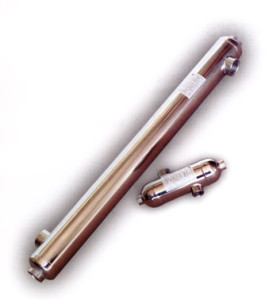
Tube & Shell Heat Exchanger
It sounds too good to be true, doesn’t it? But there is a resource that fits all of these specifications. It’s right in your backyard or down the road. Wood.
You may be saying, “But that’s old-fashioned and inefficient. Hey, and it’s a lot of work. And it’s dirty too!”
That’s not entirely true. Wood heating has come of age and the modern exterior wood furnace takes advantage of the latest developments in heating technology. Set up outside your home, and using water and heat exchangers, our furnace burns cleanly and efficiently. In most cases, it can be connected to your existing system to distribute the heat.
Because all your fuel is kept outside, you won’t have the mess associated with indoor stoves. The unit will burn all sizes and types of wood too…even those unsplittable knotty pieces. The best part is you only have to feed it once or twice a day – even in the coldest weather. Load it up in the morning and evening, and the unit will do the rest. Water heated to 185 to 200 degrees surrounds the firebox, then it courses through tubing to your home where heat exchangers convert it to hot air which is dispersed by your existing system.
Coal, gas, and oil are fossil-based, non-renewable resources. In the last year, costs for these commodities have soared along with the electricity prices.
The environmental impact of these fuels is also a factor that must be considered. The methods used to extract fossil fuels are damaging. Home systems, unless they are constantly and professionally maintained, are not efficient burners. Electricity is often produced by coal-fueled plants or by hydroelectric dams that affect our fragile ecosystems.
There is no other source of warming your home that gives you all the advantages of a timber-fueled system. It’s environmentally friendly, cost-effective, and efficient. And with a little extra work, you can get all this for free. This is an energy source that grows virtually everywhere. The property is constantly being cleared and the leavings is perfect for your use. Haul it home and you and your family are warm all winter for the cost of a tank of gas.
Alternative Heating & Supplies prides itself on bringing you the latest innovations in this technology, along with full-service parts and accessories. We have years of experience and can advise you on choosing the right equipment for your home.
So what are you waiting for? These days we talk a lot about heating our homes with alternative fuels. Isn’t it time to do more than just talking about it?
Types of Pool Heat Exchangers
There are several different kinds of heat exchangers and there are all different shapes and sizes. There's what is most commonly called, for heating pools and spas is a shell and tube heat exchanger.
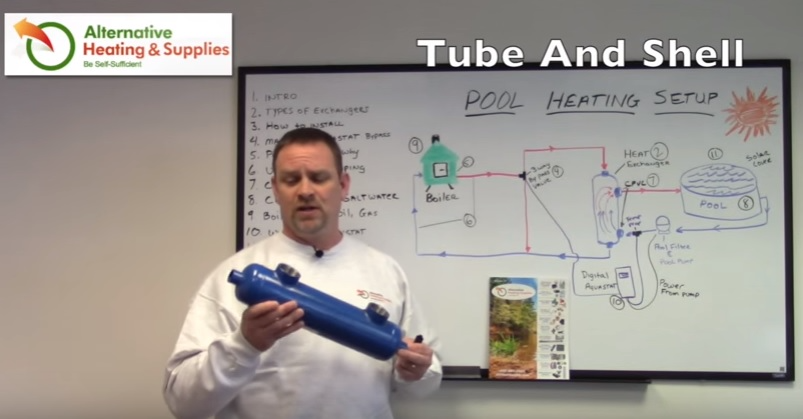
The Tube and Shell Heat Exchanger
The tube and shell is a design system that basically sends your pool or spa water through these ports, the larger ports, to make sure you have the water flow through them. Your boiler waters are going to come in through the top and the bottom of this application.
Not all tube and shells are designed the same.
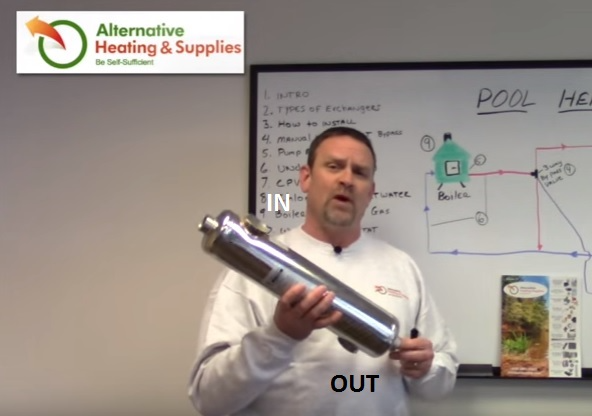
Tube and Shell from Alternative Heating and Supplies
In this case, this one comes in from this side and exits this side and the boiler ports are from the top and the bottom as well.
What Makes a Good Pool Heat Exchanger?
What makes a good pool heat exchanger in a tube and shell is the quality of the stainless steel as well as the thickness of it.
In this case, my equivalent heat exchangers that I sell compared to this one is about 40% heavier. So my stainless steel is considerably thicker. That works against me sometimes because I lose some of my heat exchange. However, I would rather have the durability and the longevity of a quality heat exchanger over losing a little bit of heat in the pool or taking it a little bit longer to heat up.
That's all the real difference is instead of going through un-plumbing and re-plumbing it in and, in my case, having a warranty and losing money on the deal.
You don't want to go through that, I don't want to go through that! So I advise you to buy a quality heat exchanger the first time and it is going to make your life and your life a lot easier and the price is about the same.
370,000 BTU Heat Exchanger
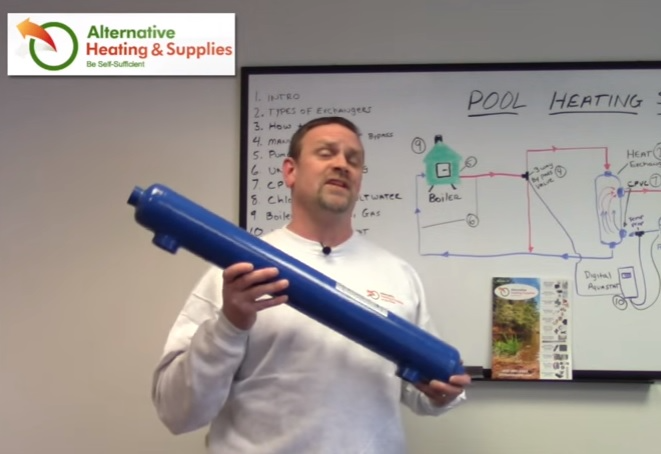
The 370000BTU-Heat-Exchanger
This is another tube and shell heat exchanger.
This is a much larger one, this is about 370,000 BTUs. This is enough to heat an average sized swimming pool, anywhere in the ballpark of 15,000 to 25,000 gallons.
I can help you calculate that, or the website also can help you figure that out. Basically, the water comes into this large port from the pool and there are tubes inside this that the water from the boiler is going through, which separates the pool from the boiler water.
Cupro-Nickel Heat Exchanger
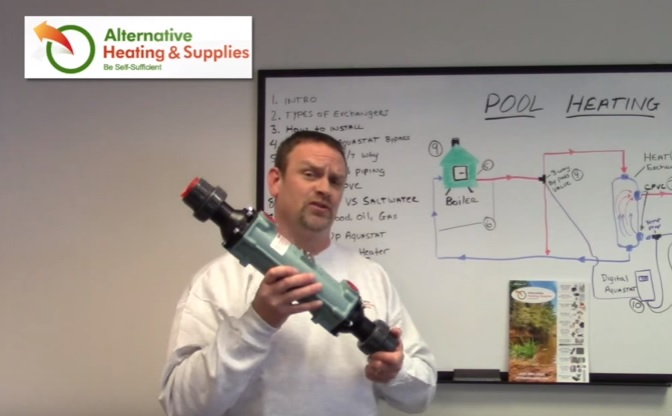
The Cupro-Nickel Heat-Exchanger
There's another heat exchanger, which is also a tube and shell design. The pool water comes in at the top this time and out the bottom. The boiler water goes on the sides.
The difference with this one, this is what they call a Cupro-Nickel. Cupro-Nickel is capable of handling salt water pools. It can also handle chlorine and is a much higher-grade heat exchanger. This Cupro-Nickel Heat Exchanger has the capability of being cleaned by taking off the top and bottom and get to the fingers that go through the whole heat exchanger.
They also come with a CPVC union to take on and off as your season comes to an end and the beginning. These Cupro-Nickel heat exchangers are considerably more expensive because they can handle the salt water. The stainless steel cannot handle salt water for very long. It can do okay, but in a saltwater pool application, we recommend you go to the Cupro-Nickel heat exchanger.
Saltwater heat exchangers will have a shortened lifespan. Probably a lot longer than most people think, but we recommend that you go right to the Cupro-Nickel heat exchanger for saltwater applications.
Monitoring the Chlorine Level
On the chlorinated pool, you need to monitor even with the stainless steel and the high quality that we sell, you also need to monitor your chlorine. The chlorine levels get too high, chlorine is basically an acid, it cleans the bacteria and cleans the pool. It will also start to eat the stainless steel if the chlorination level gets way too high. I'll go into more depths than that later.
The Plate Design Heat Exchanger
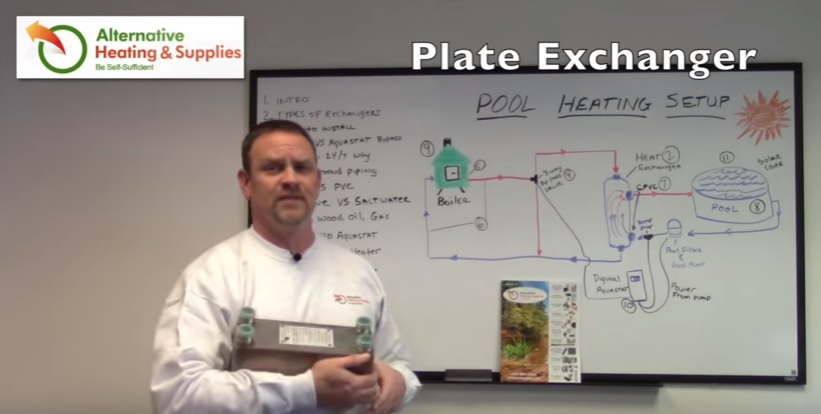
Plate Heat Exchanger
The other heat exchanger is called a Brazed Plate Heat Exchanger. This is one of the ones that most people ask me about because it is considerably cheaper than the tube and shell designs. They are also made from stainless steel. They have a lot more surface area, so they heat faster.
Plate Heat Exchanger Issues
The problem with them in a pool application is that the port sizes are only an inch. That means you can only get as much as, depending on the pressure in which your pump produces, as much as 20 gallons a minute, which is not usually enough for a pool.
The other problem is they're usually brazed, and when the brazing is done with a copper, and that will also be eaten by the salt water or the chlorination in the pool.
So again, these will last quite a while, but they do not last as long as the other options because they are not designed to. These are designed to heat up with boilers inside and also domestic hot water heaters.
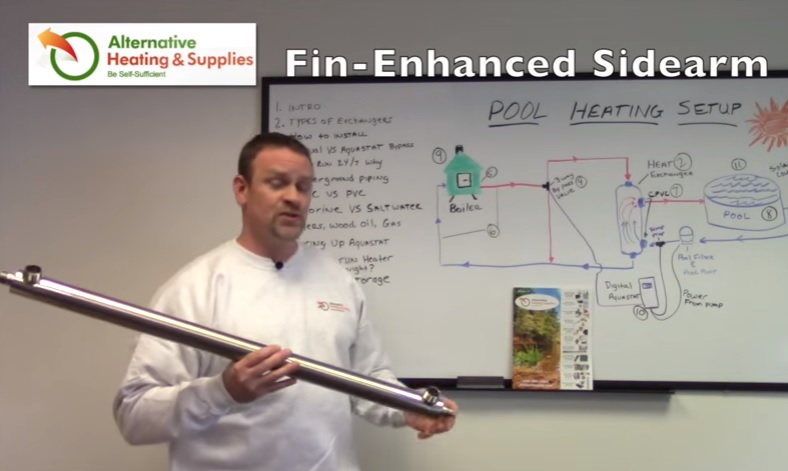
Fin Enhanced Sidearm Heat Exchanger
And finally, I get the question of the Side Arm Heat Exchanger, which is also a tube and shell design, stainless steel, same design as the prior options, but they are not designed to handle the water flows. Once again, they’re not designed to handle the pool and spa like the other heat exchangers are designed to do.
The Side Arm heat exchangers are also very well made follow the same design of the tube and shell. These side arm heat exchangers are designed to run off the side of a domestic hot water tank and they're supposed to work on convection, so they're not designed to have big gallons per water flow.
So those are the basic, tube and shell, sidearm, plate exchanger, those are the basic styles of plate exchangers that are applicable to a pool. And I'll go deeper into how they'll apply and the best way to install them.
How to Install the Pool Heat Exchanger
What I'm going to go over now is how to install and how it will look when you're hooking the pool heat exchanger up to your pool. Below is the diagram for hooking up the pool heat exchanger to your pool.
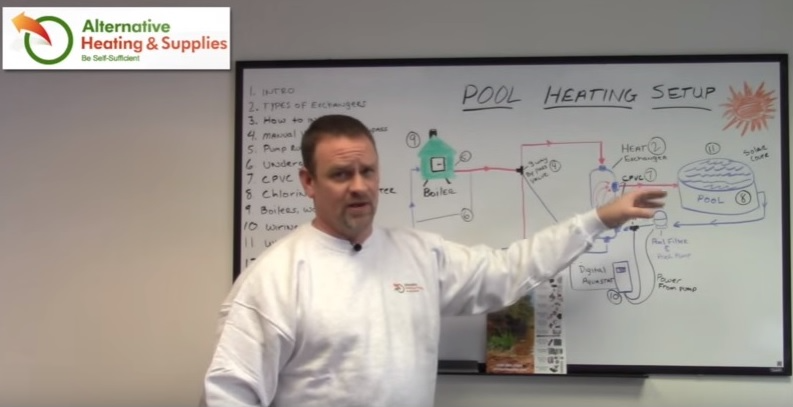
Pool Heating Setup
For examples sake, you've got your basic swimming pool and it can be in-ground or above ground. When the water comes out of the pool it generally goes to the pool filter in the pool pump. Usually before you had the heating system, it would go right back to the pool to be filtered back into the pool to keep the water circulating. In this case, this is where you're going to add your tube and shell heat exchanger, or whatever heat exchanger you decide.
Alternative Heating & Supplies highly recommends the tube and shell heat exchanger.
The tube and shell, as you'll see, comes in and goes into the heat exchanger and goes back out to the pool after the water has been re-heated. It is now hooked to a conventional heating boiler.
This could be your indoor wood boiler, this could be your outside wood boiler, this could be a wood boiler of any kind.
The water temperature of a wood boiler runs anywhere from 160 to 180 degrees and that's all we need. The water from the boiler is going to go through the heat exchanger, which is going to exchange the heat from the pool water, putting it back into the pool, and then returning to the boiler to be reheated.
In this process, we're also going to mount the filter and the chlorinator. You don't want it in front of the filters. You want the water to be filtered first, the chlorination added, then into the tube and shell heat exchanger.
In the process here, we're going mount a tee where we're going to mount a thermal well, which goes into the water of the pool where the temperature probe of the aquastat, to regulate the temperature of the pool. We have kits, which that will simplify this whole installation process.
And that will be mounted in here to monitor when the filter should be on and when it should be bypassed. I'll go into a little more detail.
How do We determine What the Pool Water Temperature Is?

The Aquastat
When the probe senses the aquastat it will go into the thermowell to read the temperature that you set for your pool. For example, 89 degrees.
A lot of you are probably thinking that's a little warm, but it's where the wife and the kids are the happiest and that's the most important part in life.
So once this aquastat says that it's 80 or 88 degrees, it's going to turn on this three-way valve from the boiler. Let’s say that I want the water to go through the heat exchanger and then back to the boiler to get reheated.
When the pool and the temperature have been reached, it is going to read 89 degrees, it's going to say that we're all set. From there the aquastat will tell the valve to shut this way and it's going to send the water from the boiler back to the boiler just to bypass the heat exchanger. That's how we determine what the pool water temperature is.
The pool filter, since we cannot control when the pool is turning on and off, we power the aquastat and the valve by the pool filter and chlorinator, whatever you have, you have 110 volts or 220 volts going into that thing, so we're going to power the aquastat and the three-way valve by this. So when the pool filter is on, the heating system is activated.
Now, the reason you want that to be powered while the pool filter is running is if that if this is sensing the water is cold and the pool filter is not running through this loop, the water is going through that heat exchanger, which is heating up the water on the pool side of the heat exchanger, which is heating the water up to 180 degrees, so it’s doing nothing.
Depending on the PVC in the piping that you have in the pool, that water will slowly heat up and get pushed towards the pool. Unfortunately, pool liners and pool materials don't handle those kinds of temperatures very well. That's why we only want the water circulating in the tube and shell heat exchanger while the pool filter is running. With the power of my aquastat and everything running off the pool, it only is going to run when the pool filter is running.
Pool Heating Setup FAQs
Do I have to reset the digital aquastat every time I power on and off the pool filter?
No, you do not have to reset the digital aquastat, because it keeps the settings that you have made.
Be sure to check out the next video where we talk about how to hook up a wood boiler to a swimming pool. Be sure to subscribe to our Alternate Heating & Supplies Youtube channel as well! Missing a part or two? Check out our catalog! Contact us at Alternative Heating & Supplies for any and all inquiries!
